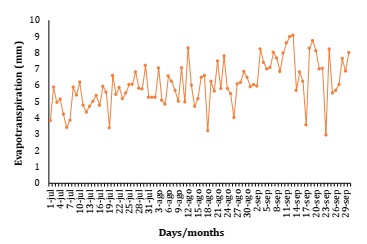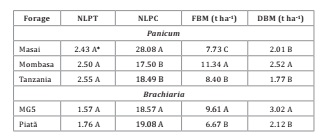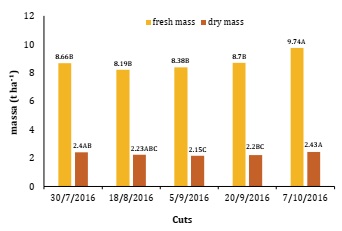Introduction
The Goiás’ Cerrado has a seasonal tropical climate with rainy summers and dry winters. The temperature can reach 40°C in summer and 10°C in winter. The average annual rainfall is approximately 1500 mm, and is distributed between October and April. In winter, the days are shorter, whereas in summer, they are longer.
It is estimated that the Cerrado has 50 million ha of cultivated pastures 24. In the pastures in the Goiás’ Cerrado, grasses of the genus Brachiaria are predominantly grown 5,18; however, the areas cultivated with Panicum have been significantly increasing. These plants have a C4 carbon fixation metabolism and generally exhibit better growth and biomass accumulation at temperatures between 30 and 40°C and high luminosity.
The areas of pastures cultivated with Brachiaria species in Brazil are probably unequalled by other forages in any other country with a tropical climate, especially at the national level with Brachiaria brizantha cv. MG-5 7. On the other hand, Panicum maximum is one of the main forage species cultivated worldwide, and is highly valued for its dry matter production and forage quality 23.
In tropical regions, rain is the main factor that limits the growth and accumulation of forage mass, and it has been verified that the seasonality of rainfall influences the increase in biomass of Pennisetum purpureum cv. Roxo 16. The seasonality of Brachiaria brizantha cv. Marandu production, even with fertigation, had higher values in spring and summer and lower values during the autumn-winter season 22.
Nevertheless, the seasonality in the growth and accumulation of biomass depends on the interaction of the plants with edaphoclimatic conditions, and in some cases, the water supply does not provide the maximum forage yield. In these cases, the low yields in autumn-winter were compensated for by the better quality of forage crude protein and neutral detergent fiber 22.
The use of irrigation in pastures in the Cerrado still predominates based on the empirical experience of producers and is still not based on academic research. The authors found that dry matter production of Mombasa grass during spring was higher than that during winter, with an increase in the production of dry matter with an increase in the minimum temperature. They also defined minimum air temperature and water availability in the soil as the main factors responsible for the mass production of Mombasa grass.
Higher air temperatures, with high luminosity and moisture, stimulate the growth of C4 plants throughout the year, providing high productive potential. However, low temperatures can reduce or even prevent plant growth. Little or no growth is expected for tropical grasses when temperatures are below 15°C 17. Thus, even with irrigation, the plant did not produce good yields under these conditions 20.
Accordingly, the objective of this study was to evaluate the responses of growth and biomass accumulation of five forage plants grown under irrigation in the Goiás’ Cerrado.
Material and methods
The experiment was conducted at the Federal Institute Goiano - Campus Ceres, Ceres - GO, in a center-pivot irrigated plot, with the following Cartesian Coordinates: 15°18′49” S, 49°36´12” W, located at an approximate altitude of 570 m a. s. l.
According to Koeppen’s classification, the climate of the site is Aw, which is a tropical climate with a dry season in winter. Average minimum temperature in the coldest months was below 15°C, and in the hottest months, the average maximum temperature exceeded 35°C. The average annual rainfall is approximately 1575 mm.
The soil of the experimental area is a typical eutrophic Red Latosol with a very frank clayey texture. The chemical and physical properties of the soil in the experimental area are: 48.2% sand, 4.0% silt, 47.8% clay, pH (in water) = 5.62, organic matter (OM) = 22 g dm-3 (colorimetric), P = 50.0 mg dm-3, K = 0.56 cmolc dm-3, Ca = 3.85 cmolc dm-3, Mg = 1.94 cmolc dm-3 (KCl mol.l-1), H+Al = 3.80 cmolc dm-3 (SMP buffer at pH 7.5), and V = 62.57%. The methodology used for the soil analysis followed the recommendations of Embrapa (2011).
The average, maximum, and minimum temperatures, and evapotranspiration (Figure 1) were determined using the Class A pan evaporation method during the experimental period.

Figure 1: Evapotranspiration monitored by Class A pan evaporation method during the experimental period. Figura 1: Evapotranspiración monitoreada por el método de evaporación, tanque Clase A, durante el período experimental.
During the experiment, the following rainfall was recorded: 16/08/2016 - 42 mm, 21/08/2016 - 1 mm, 25/08/2016 - 1 mm, 01/09/2016 - 20 mm, 02/09/2016 - 2 mm, 16/09/2016 - 10 mm, 17/09/2016 - 1 mm, 25/09/2016 - 25 mm, 01/10/2016 - 18 mm, 03/10/2016 - 1 mm, 04/10/2016 - 15 mm, 05/10/2016 - 12 mm, and 06/10/2016 - 6 mm.
The experimental design was a completely random block split plots arrangement with five replicates, five forages in the plots (three of the species Panicum maximum - Mombasa, Tanzania, and Masai, two of the species Brachiaria brizantha (cultivar piatã and MG5), and five cuts in the sub-plots.
The soil was prepared in a conventional manner with one plowing and two harrowings. The deployment of forage occurred on December 29, 2015, with a distribution of 20 kg of seeds per ha, with a crop value of 50% for Brachiaria and 32% for Panicum.
Seventy days after emergence, the plants were cropped to standardize the plots, and the residues were removed, followed by application of the treatments.
The area was irrigated with a central pivot, and the water level was calculated according to the reference evapotranspiration (ET0) from a class A pan, crop coefficient of 0.80 1, and two-day irrigation shifts.
Maintenance fertilization was performed with urea, which provided 300 kg N ha-1 year-1 for Mombasa and Tanzania, 250 kg N ha-1 year-1 for Masai, and 200 kg N ha-1 year−1 for MG5 and Piatã. The distribution of fertilizer was always by haul after cropping.
The sward height was monitored twice per week. When the grasses displayed the height indicated in the literature (Mombasa 0.9 m; Tanzania 0.7 m; Masai 0.55 m; MG 5 and piatã 0.35m), the forage plants were cropped, retaining the height recommended in the literature.
Sampling was conducted on July 30, August 18, September 05, September 21, and October 07 for Mombasa, Tanzania, and Massai grass, and August 02, August 20, September 07, September 23, and October 9 for MG5 and Piatã grass, all in 2016.
For each cut, the number of tillers, leaves per tiller, leaves per plant, fresh biomass of the leaf and stem, dry leaf biomass and stem, fresh mass ratio of leaves relative to that of fresh mass, and ratio of the dry mass of leaves relative to that of dry mass of stems were evaluated. The biomass accumulated in the five cuts was estimated using the fresh and dry biomass obtained from each cut.
The results were subjected to analysis of variance (F-test at 5%), and the means were compared using the Tukey test with 5% significance using the statistical program SISVAR.
Results
During the experimental period, the maximum, minimum, and average temperatures, photoperiod, total light exposure, volume of water applied, and photothermal units, and consequently, the intervals between the cuts, were varied (Table 1).
Table 1: Intervals between cuts, maximum, minimum, average temperatures, photoperiod, total light exposure, volume of water applied, and photothermal unit during the experiment. Ceres-GO. 2016. Tabla 1: Intervalos entre cortes, máxima, mínima, temperaturas promedio, fotoperiodo, exposición total a la luz, volumen de agua aplicado y unidad fototérmica durante el experimento. Ceres-GO. 2016.

The shortest interval between cuts was 15 days, whereas the longest was 22 days, a difference of 46.6%. This demonstrates that the environmental conditions in the Goiás’ Cerrado, besides water, influence forage growth, which is in agreement with the findings from existing literature.
Regarding the number of tillers, in each cut, variation was observed among forages, with Masai standing out among the Panicum and no significant differences were found between the Brachiaria. Among the cuts, a significant difference (p < 0.05) was observed only for piatã grass (Table 2).
Table 2: Number of tillers in forage plants of Panicum and Brachiaria during five cuts. Tabla 2: Número de macollos en plantas forrajeras del género Panicum y Brachiaria durante cinco cortes.

* Means in the rows followed by the same letter and means in the column followed by the same letter do not differ by Tukey’s test at 5% significance.
* Medias en las filas seguidas por la misma letra y medias en la columna seguida por la misma letra no difieren por la prueba de Tukey al 5% de significación.
** Dates of cuts of Mombasa, Masai, and Tanzania grasses: 30/07/2016; 18/08/2016; 05/09/2016; 20/09/2016; and 07/10/2016. Dates of cuts for MG5 and Piatã 02/08/2016; 20/08/2016; 07/09/2016; 23/09/2016; and 09/10/2016.
** Día de corte de Mombasa, Masai y Tanzania: 30/07/2016; 18/08/2016; 09/05/2016; 20/09/2016; y 10/07/2016. Fechas de cortes para MG5 y Piatã 08/02/2016; 20/08/2016; 09/07/2016; 23/09/2016; y 10/09/2016.
The number of leaves per tiller of forage grass was not significantly different. Regarding the number of leaves per plant, Masai was superior to Mombasa and Tanzania, whereas no differences were observed between the Brachiaria grasses (Table 3).
Table 3: Number of leaves per tiller (NLPT), number of leaves per clump (NLPC), fresh biomass (FBM), and dry biomass (DBM) between cuts in forage plants of the genus Panicum and Brachiaria. Tabla 3: Número de hojas por macollo (NLPT), número de hojas por racimo (NLPC), biomasa fresca (FBM) y biomasa seca (DBM) entre cortes en plantas forrajeras del género Panicum y Brachiaria.

* Means in the column followed by the same letter do not differ according to Tukey’s test at 5% significance.
* Medias en la columna seguida de la misma letra no difieren por la prueba de Tukey al 5% de significación.
In relation to the total fresh and dry weights of aerial parts, Mombasa grass stood out among the Panicum grasses, whereas MG5 was superior to piatã among the Brachiaria grasses (Table 3).
The ratio of fresh leaf mass to fresh stem mass did not vary among the forage grasses. In turn, regarding the ratio of dry leaf mass to dry stem mass, Masai grass was superior to Mombasa and Tanzania grass, whereas MG5 and piatã grass did not differ. The fresh and dry masses varied between cuts. The highest fresh mass was obtained in the cutting with higher average, maximum, and minimum temperatures and photoperiods. Dry mass did not show this trend (Figure 2).

Figure 2: Accumulation of fresh and dry biomass (t ha-1) among the forages in each cut. Figura 2: Acumulación de biomasa fresca y seca (t ha-1) entre los forrajes de cada corte.
Mombasa grass displayed a higher accumulated fresh mass in the five cuts, whereas MG5 grass had a higher accumulated dry mass in the five cuts (Table 4).
Table 4: Total fresh biomass (TFBM) and total dry biomass (TDBM) accumulated in the five cuts, percentage of dry biomass (% DBM), percentage of leaves (%), and percentage of stems (%) in forage grown in the winter under irrigation in the Goiás’ Cerrado. Tabla 4: Biomasa fresca total (TFBM) y biomasa seca total (TDBM) acumulada en los cinco cortes, porcentaje de biomasa seca (% DBM), porcentaje de hojas (%) y porcentaje de tallos (%) en forraje cultivado en el invierno bajo riego en el Cerrado de Goiás.

* Means in the rows followed by the same letter and means in the column followed by the same letter do not differ by Tukey’s test at 5% significance.
* Medias en las filas seguidas por la misma letra y medias en la columna seguida por la misma letra no difieren por la prueba de Tukey al 5% de significación.
The ratio of dry mass to fresh mass of forage ranged from 20 to 32.41%. The highest percentage was obtained with MG5 grass, and the lowest with Tanzania grass. For the grasses of the genus Panicum, this ratio ranged between 20 and 26%, and for Brachiaria, the ratio was above 32% (Table 4). The ratio of leaf tissue to total biomass was more than 90% in forage plants of the genus Panicum and between 71% and 73% in Brachiaria (Table 4).
Discussion
Forage irrigation in winter provided satisfactory growth, overcoming the limitations of growth and biomass production and allowing forage production to be scaled up in the Central-West region of Brazil 15.
The forages studied were C4 plants, which have a higher production of photoassimilates and, consequently, higher growth, at air temperatures between 30 and 40°C and with higher luminosity. When temperatures are between 10 and 15°C, the growth of tropical grasses is hindered; therefore a standard base temperature of 15°C was adopted for the growth of these plants. However, there are differences between species and cultivars. Moreno et al. (2014) estimated the base temperatures to be 16°C for Masai, 11°C for Mombasa, and 7°C for Tanzania grass. For Brachiaria MG5 and Piatã, there is no published information on base temperatures, whereas for other Brachiaria, it is reported as above 16°C.
Brachiaria MG5 grew to a height above 35 cm, with intervals between cuts maintained to be at least 20 days 7. For plants of the genus Panicum, the interval was approximately 28 d. Temperature was not a limiting factor for the growth of the forages studied, and the irrigation of forage during the winter in the Goiás’ Cerrado yielded plant heights at intervals between the croppings that were below published values 4.
In the Southeast and Central-West regions of Brazil, the predicted herbage accumulation rate of P. maximum increased from October onwards, reached its highest values in January (100-120 kg DM ha-1 d-1), and decreased again in May 19. However, with irrigation, it was possible to anticipate the growth of fodder during winter in Ceres, Goiás, Brazil.
Prado et al. (2014) did not observe any changes in the population density of tillers as a function of the intensity and frequency of defoliation, whereas the number of tillers increased with increasing P in a greenhouse 10.
In studies conducted with Masai grass, the number of leaves per tiller was higher, ranging from 4.1 to 5.4 with 0 and 160 kg N ha-1 year-1, respectively 8. The number of green leaves in Mombasa grass responded to N doses, reaching values of 5.90 leaf tiller-1 with 269 kg N ha-1 (3. Decreases in temperature and photoperiod decreased the fresh and dry mass, height of aerial parts, density of tillering, leaf area, chlorophyll content, and relative water content in Cynodon dactylon12.
The photoperiod and temperature influenced the productivity of Tanzania grass, even without a water deficit 21. The production of fresh and dry mass in Mombasa and Masai grass was lower in months with lower temperatures and shorter days 13. Piatã and MG5 grasses also presented lower yields of green and dry biomass in the months with shorter days and lower temperatures 19. This pattern was not observed in the accumulation of dry mass under the conditions of the Goiás’ Cerrado with the use of pivot irrigation, indicating a way to minimize seasonality in the production of these forages under these conditions.
In the evaluation of the six forage grasses managed by grazing under the effect of different nitrogen doses and annual seasons, MG5, Mombasa, and Tanzania grass had higher rates of fresh biomass and dry matter 2. This divergence in the responses of forage indicates the need to evaluate and select plants that are more promising for specific climatic conditions in each region 6.
A ratio of 19 to 23% was observed between the culture seasons with Panicum grass 23. The ratio of dry mass to fresh mass in Brachiaria ruziziensis was approximately 23% 9, 69.6% for marandu, and 93.4% for Mombasa grass 14.
Conclusion
The forages showed satisfactory responses in growth and biomass accumulation in an irrigated culture during winter in the Goiás’ Cerrado. Mombasa grass stood out among the forages of the genus Panicum and MG5 in Brachiaria. Thus, Mombasa and Brachiaria MG5 grasses are recommended for the cultivation of irrigated forage during winter in the Goiás’ Cerrado.














